9.1: Introducing Ratios and Ratio Language
- Page ID
- 39920
Lesson
Let's describe two quantities at the same time.
Exercise \(\PageIndex{1}\): What Kind and How Many?
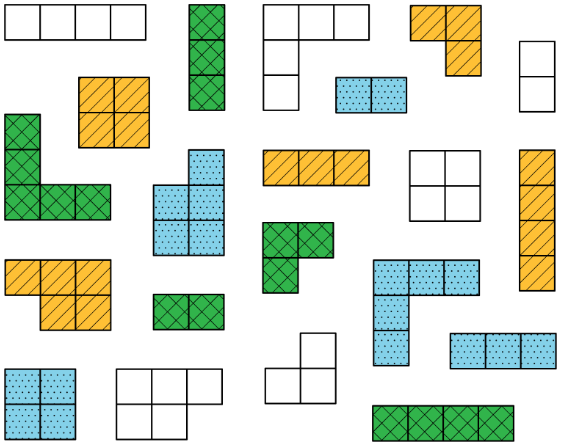
Think of different ways you could sort these figures. What categories could you use? How many groups would you have?
Exercise \(\PageIndex{2}\): The Teacher's Collection
- Think of a way to sort your teacher’s collection into two or three categories. Count the items in each category, and record the information in the table.
| category name | |||
|---|---|---|---|
| category amount |
Pause here so your teacher can review your work.
- Write at least two sentences that describe ratios in the collection. Remember, there are many ways to write a ratio:
- The ratio of one category to another category is ________ to ________.
- The ratio of one category to another category is ________ : ________.
- There are _______ of one category for every _______ of another category.
Exercise \(\PageIndex{3}\): The Student's Collection
- Sort your collection into three categories. You can experiment with different ways of arranging these categories. Then, count the items in each category, and record the information in the table.
| category name | |||
|---|---|---|---|
| category amount |
- Write at least two sentences that describe ratios in the collection. Remember, there are many ways to write a ratio:
- The ratio of one category to another category is ________ to ________.
- The ratio of one category to another category is ________ : ________.
- There are _______ of one category for every _______ of another category.
Pause here so your teacher can review your sentences.
- Make a visual display of your items that clearly shows one of your statements. Be prepared to share your display with the class.
Are you ready for more?
- Use two colors to shade the rectangle so there are 2 square units of one color for every 1 square unit of the other color.
- The rectangle you just colored has an area of 24 square units. Draw a different shape that does not have an area of 24 square units, but that can also be shaded with two colors in a \(2:1\) ratio. Shade your new shape using two colors.
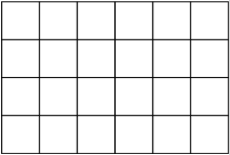
Summary
A ratio is an association between two or more quantities. There are many ways to describe a situation in terms of ratios. For example, look at this collection:

Here are some correct ways to describe the collection:
- The ratio of squares to circles is \(6:3\).
- The ratio of circles to squares is 3 to 6.
Notice that the shapes can be arranged in equal groups, which allow us to describe the shapes using other numbers.

- There are 2 squares for every 1 circle.
- There is 1 circle for every 2 squares.
Glossary Entries
Definition: Ratio
A ratio is an association between two or more quantities.
For example, the ratio \(3:2\) could describe a recipe that uses 3 cups of flour for every 2 eggs, or a boat that moves 3 meters every 2 seconds. One way to represent the ratio \(3:2\) is with a diagram that has 3 blue squares for every 2 green squares.
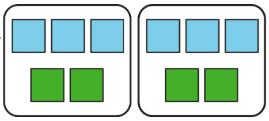
Practice
Exercise \(\PageIndex{4}\)
In a fruit basket there are 9 bananas, 4 apples, and 3 plums.
- The ratio of bananas to apples is ________ : ________.
- The ratio of plums to apples is ________ to ________.
- For every ________ apples, there are ________ plums.
- For every 3 bananas there is one ________.
Exercise \(\PageIndex{5}\)
Complete the sentences to describe this picture.

- The ratio of dogs to cats is ________.
- For every ________ dogs, there are ________ cats.
Exercise \(\PageIndex{6}\)
Write two different sentences that use ratios to describe the number of eyes and legs in this picture.
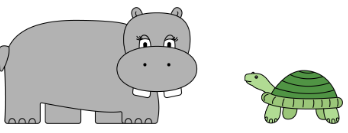
Exercise \(\PageIndex{7}\)
Choose an appropriate unit of measurement for each quantity.
- area of a rectangle
- volume of a prism
- side of a square
- area of a square
- volume of a cube
- cm
- cm3
- cm2
(From Unit 1.6.1)
Exercise \(\PageIndex{8}\)
Find the volume and surface area of each prism.
- Prism A: 3 cm by 3 cm by 3 cm
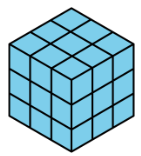
- Prism B: 5 cm by 5 cm by 1 cm

- Compare the volumes of the prisms and then their surface areas. Does the prism with the greater volume also have the greater surface area?
(From Unit 1.5.5)
Exercise \(\PageIndex{9}\)
Which figure is a triangular prism? Select all that apply.
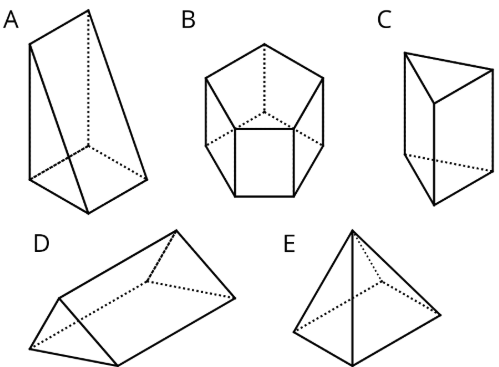
- A
- B
- C
- D
- E
(From Unit 1.5.2)


